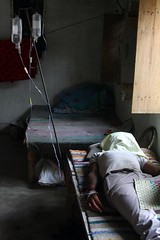So what to do if you're sick? One option is to go to a rural health provider... they actually call themselves "quacks." And yeah, they may or may not know what they're doing.
Man with fever getting an IV drip from a quack.

Another option is to self-medicate at your local village pharmacy. Or you could just spend a lot of money and time traveling back and forth into town. Even though it may be a 12km (7 mile) trip, public transportation can take all day long. Of course, this is assuming you don't have to take care of children or are too old to travel.
One technology that has great promise for reducing this inequity is telemedicine.

In a nutshell, telemedicine enables realtime audio/video consultation with a doctor someplace else like in New Delhi. The system is even capable of transmitting temperature, EKG, heart rate, and ultrasound images! Furthermore, the technology is already widely available in India has existed on a small scale. For my doctoral dissertation, I'll be researching the implementation of several hundred of these telemedicine clinics as a primary care center in villages in Uttar Pradesh, one of the poorest states in India.





No comments:
Post a Comment